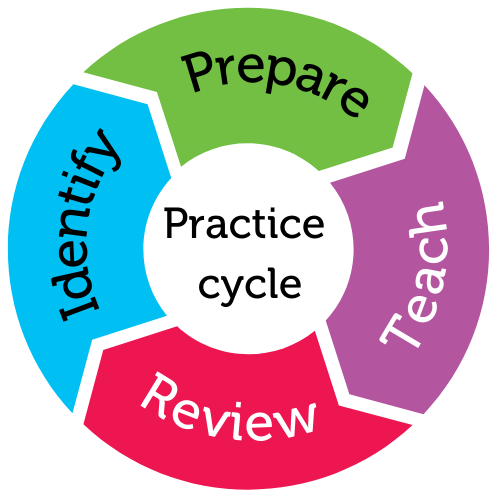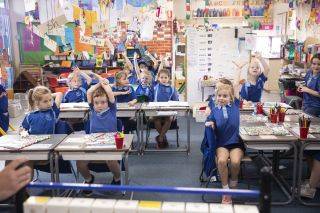
For student year
Helps students to
- feel valued
- engage in interactions
Helps teachers to
- model strategies
- cater to student strengths
Summary
Some students, including those on the autism spectrum, may have difficulty with social interactions and need support to feel accepted and fit in. You can support these students by planning genuine student interactions when you structure the learning and social life of your classroom. Proactive planning to interact with every student will develop and practice friendly and responsive interaction “styles” that will encourage communication exchanges and help build your relationships with students.
How the practice works
Watch this video to learn more.
Duration: 2:45
Australian Professional Standards for Teachers related to this practice
1.1 - physical, social and intellectual development and characteristics of students
4.1 - support student participation
For further information, see Australian Professional Standards for Teachers AITSL page
Preparing to teach
How does it help?
By having positive and respectful interactions with every student, you will be in a better position to cultivate meaningful relationships and build classroom environments that are:
- well-regulated
- socially positive
- inclusive.
Meaningful teacher-student relationships:
- are mutually respectful
- are supportive
- positively influence student engagement and achievement
- promote social and emotional development.
Interactions can be verbal, non-verbal, or both.
Reflect on:
- your relationship
- the quality of interactions with each of your students.
Observe the student and chat with family members and colleagues so you can prepare a list of topics that students will be more motivated to engage with.
Choose interactions which will help support and build positive learning experiences, play, and peer-relationships.
Plan your communication
A direct questioning style, especially one that involves so-called 'closed questions' that are obvious and require only one-word answers, may prove counterproductive to your attempts to interact with students. Even teachers with genuine intentions to share students’ interests might use conventional questions that students offer minimal or even no response to.
Direct questions
Direct questioning can be confronting, difficult to process, or even meaningless to a student on the autism spectrum.
“How are you today?” Sam’s answer “Good.”
“What are you building with the Lego?” Sam’s answer: “Robot.”
“You like that book about trains, don’t you?” Sam’s answer: “Yes.”
Statements
A more open, lateral and complimentary statement-based style may motivate students and elicit more sustained responses.
“Hi Sam, it’s good to see you! We’ve got some interesting things happening today.”
“Wow, this robot is amazing! I wonder how it moves.”
“I like trains too – I think my favourite is the Japanese bullet train.”
It works better if:
- there are frequent one-to-one interactions which include supporting play and peer interactions
- you take student’s unique abilities, interests, and needs into account when identifying and engaging in interactions
- the student signals (possibly non-verbally) that he/she is ready to engage in an interaction.
It doesn’t work if:
- you insist on engaging with a student who shows (verbally or non-verbally) that he/she is not interested in interacting or that the interaction is finished
- communication is based on a closed-questioning style
- you engage in an interaction while angry or frustrated.
In the classroom
Understand every student
Every teacher-student interaction is an opportunity to develop and enhance teacher-student relationships.
- Be aware of and respect each students’ abilities and needs.
- Get to know your students' interests and passions.
- Respond to his/her own emotional states and communication styles.
- Create or identify the opportunities for genuine interaction with your students throughout the day.
- Know how a student signals (possibly non-verbally) that he/she is ready to engage in an interaction.
- Plan how you will respond respectfully to students and just move on calmly, e.g.:”OK Sam, thanks. I like our talks”.
When you understand each students’ social, learning, sensory needs and stressors, you can prepare how to respond respectfully if a student demonstrates that an interaction is not currently welcome.
Step 1. Engage one-to-one
Check for student signals (possibly non-verbally) that he/she is ready to engage in an interaction.
Engage in one-to-one interactions with the student as planned e.g., welcome the student at the start of the day.
Introduce topics that the student is interested in. You can do this formally e.g., topic-based class news times or informally.
Use 'labelled praise':
“Sam, your drawings are wonderful – you’re a clever artist! I wonder if you draw a lot at home too.”
Avoid engaging in interactions when you are angry or frustrated. Model calm control and refer to visual supports to redirect students.
Step 2. Watch
Watch the student’s interaction carefully and respond accordingly.
Follow the student’s lead during interactions, including play.
Step 3. Respect
Respect when a student shows that the interaction is:
- not welcome
- finished.
Step 4. Evaluate
Evaluate interactions with a particular student.
Identify possible areas for improving the quality of the interaction.
Practice toolkit
Practice implementation planner template
We know it's not always easy to keep track of what's working and what isn't. So, we've created this template for you to record and reflect on what you're doing to create more inclusive classrooms. The implementation planner contains:
- guidance around goal setting
- a reflection section (what worked, didn’t work, what to change, and next steps)
- prompting questions.
Implementation planner with examples
Set your professional learning goal for:
Interact with every student
Benefits of goal setting
Setting, working towards, and reflecting on goals helps you grow professionally and improve your practice. You can access AITSL learning resources for teachers to learn more about:How to set goals
The Australian Institute for Teaching and School Leadership recommends using the SMART matrix to frame your goal setting.SMART goals refers to goals that are:
- Specific
- Measurable
- Achievable
- Relevant
- Time-phased
Resources
Interact with every student - Practice Brief
Related Practices

Model positive interactions
TEACHING PRACTICE
For student years
Helps students to
- build social-awareness
- interact with others
This practice is from the core research project
Learning Cycle

